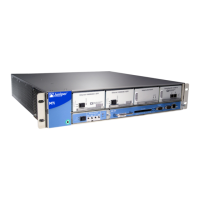CHAPTER 20
Configuring the Junos Software
•
Initially Configuring the M7i Router on page 129
Initially Configuring the M7i Router
The router is shipped with the Junos OS preinstalled and ready to be configured when
the router is powered on.
The default boot order for the M7i Multiservice Edge Router is different from other Juniper
Networks routers, because the default configuration of the Routing Engine on the M7i
router does not include an CompactFlash card.
If the Routing Engine does not have an CompactFlash card, two copies of the Junos OS
are preinstalled on the router: one on a PC card that can be inserted into the slot in the
Routing Engine faceplate, and one on a rotating hard disk in the Routing Engine. When
the router boots, it first attempts to access the software image on the PC card. If a PC
card is not inserted into the Routing Engine or the attempt otherwise fails, the router tries
the hard disk.
If the Routing Engine has an CompactFlash card, three copies of the Junos OS are
preinstalled on the router and the boot order is as follows. The router first attempts to
access the image on the PC card. If a PC card is not inserted into the Routing Engine or
the attempt otherwise fails, the router next tries the CompactFlash card, and finally the
hard disk.
You configure the router by issuing Junos OS command-line interface (CLI) commands,
either on a console device attached to the CONSOLE port on the Routing Engine, or over
a telnet connection to a network connected to the MGMT port on the Routing Engine.
Gather the following information before configuring the router:
•
Name the router will use on the network
•
Domain name the router will use
•
IP address and prefix length information for the Ethernet interface
•
IP address of a default router
•
IP address of a DNS server
•
Password for the root user
129Copyright © 2019, Juniper Networks, Inc.

